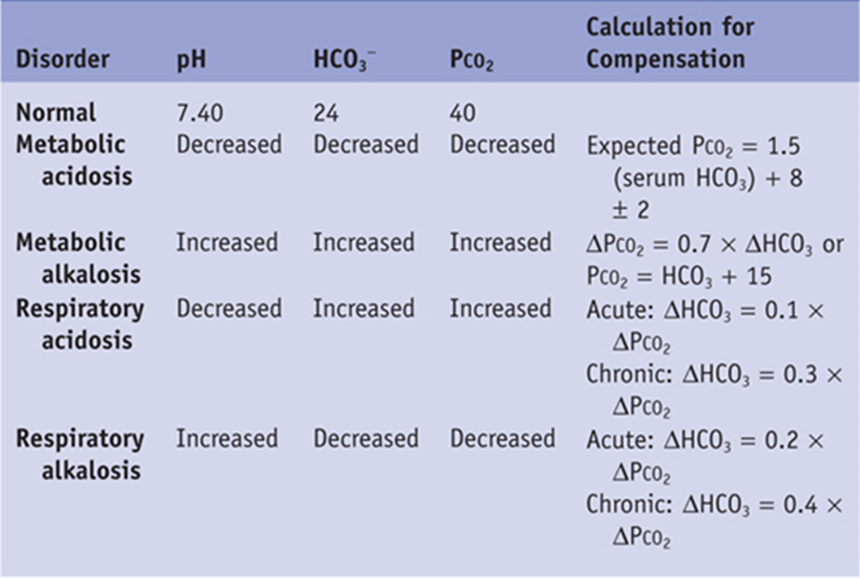The nurse reviews the blood gas results of a client with atelectasis. The nurse analyzes the results and determines that the client is experiencing respiratory acidosis. Which results validate the nurse's findings?
pH 7.28, pCO2 36, HCO3 23
pH 7.52, pCO2 28, HCO3 25
pH 7.25, pCO2 50, HCO3 22
pH7.35, pCO2 40, HCO3 24
The Correct Answer is C
A. pH 7.28, pCO2 36, HCO3 23:
Explanation: The pH is low, indicating acidosis. However, the pCO2 is within the normal range, which is not consistent with respiratory acidosis. The HCO3 is slightly low but not significantly, and this doesn't align with typical findings in respiratory acidosis.
B. pH 7.52, pCO2 28, HCO3 25:
Explanation: The pH is high, indicating alkalosis. The pCO2 is below the normal range, which is not consistent with respiratory acidosis. The HCO3 is within the normal range, and these values are not typical for respiratory acidosis.
C. pH 7.25, pCO2 50, HCO3 22:
Explanation: The pH is low, indicating acidosis. The pCO2 is elevated, which is typical in respiratory acidosis. The HCO3 is within the normal range, suggesting uncompensated respiratory acidosis.
D. pH 7.35, pCO2 40, HCO3 24:
Explanation: The pH is within the normal range, and both pCO2 and HCO3 are normal. These values do not indicate acidosis.

Nursing Test Bank
Naxlex Comprehensive Predictor Exams
Related Questions
Correct Answer is ["A","B"]
Explanation
A. I will inject my insulin by pinching up a large area of skin, and then inserting the needle.
The correct technique for subcutaneous insulin injection involves pinching a small area of skin (creating a skinfold) and inserting the needle at a 90-degree angle. Injecting into a large area might result in inadequate subcutaneous administration.
B. I can mix my regular acting insulin and my Lantus in the same syringe.
Lantus (insulin glargine) is a long-acting insulin that should not be mixed with other insulins. It should be administered separately to maintain its long-acting profile.
C. I can inject my insulin in the same location each time.
This statement is correct. Injecting insulin into the same general area consistently can help with consistent absorption.
D. I can use a needle/syringe more than once since I am the only one using it.
It is not safe to reuse needles or syringes. Single-use needles and syringes should be disposed of properly after each use to prevent infection and other complications.
E. I will discard my used syringes in a hard container, like an empty plastic milk jug.
This statement is correct. Used syringes should be discarded in a puncture-resistant container, and an empty plastic milk jug can serve as a suitable container for disposal.
Correct Answer is A
Explanation
A. Metabolic Alkalosis:
pH: Elevated (alkalotic).
PaCO2: Normal or slightly decreased (compensation may or may not be present).
HCO3: Elevated.
Explanation: Metabolic alkalosis is characterized by an excess of bicarbonate (HCO3) in the blood, leading to an elevated pH. In this case, the elevated pH and HCO3 levels suggest that the primary imbalance is metabolic alkalosis.
B. Respiratory Alkalosis:
pH: Elevated (alkalotic).
PaCO2: Decreased (due to hyperventilation, which blows off CO2).
HCO3: Normal or slightly decreased (compensation).
Explanation: Respiratory alkalosis is characterized by low levels of carbon dioxide (PaCO2) due to hyperventilation. However, in the provided ABG, the PaCO2 is not significantly decreased, suggesting that respiratory alkalosis is not the primary issue.
C. Respiratory Acidosis:
pH: Decreased (acidotic).
PaCO2: Increased (due to inadequate ventilation).
HCO3: Normal or slightly elevated (compensation).
Explanation: Respiratory acidosis is characterized by an increase in carbon dioxide (PaCO2) levels. In this case, the PaCO2 is within the normal range, indicating that respiratory acidosis is not the primary problem.
D. Metabolic Acidosis:
pH: Decreased (acidotic).
PaCO2: Normal or slightly decreased (compensation).
HCO3: Decreased.
Explanation: Metabolic acidosis is characterized by a decrease in bicarbonate (HCO3) levels. In this ABG, the HCO3 is elevated, ruling out metabolic acidosis as the primary issue.
Whether you are a student looking to ace your exams or a practicing nurse seeking to enhance your expertise , our nursing education contents will empower you with the confidence and competence to make a difference in the lives of patients and become a respected leader in the healthcare field.
Visit Naxlex, invest in your future and unlock endless possibilities with our unparalleled nursing education contents today
Report Wrong Answer on the Current Question
Do you disagree with the answer? If yes, what is your expected answer? Explain.
Kindly be descriptive with the issue you are facing.
